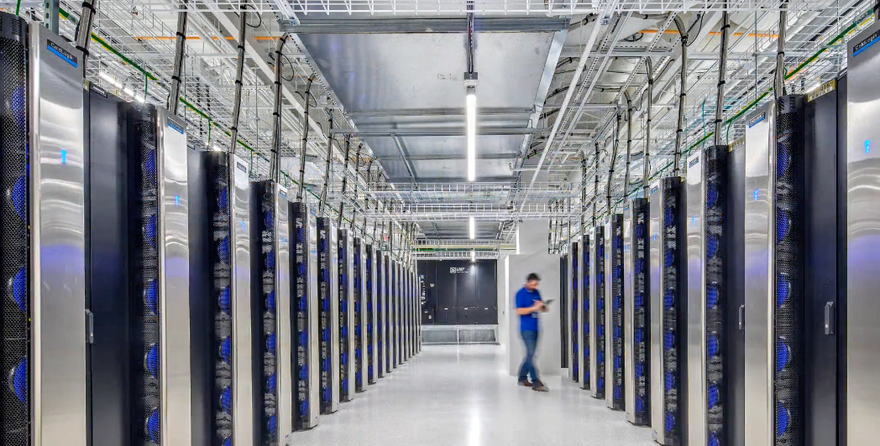Artificial intelligence (AI) is not just a trend; it is rapidly becoming the dominant force driving IT infrastructure and data center design. AI’s impact on data centers is profound and multifaceted, reshaping infrastructure requirements as it drives the demand for increased power consumption and high-power density environments.
Cooling and sustainability challenges
From machine learning models to real-time data analytics, AI requires vast amounts of computational power and data storage. This has led to a significant increase in the need for high-performance servers equipped with powerful GPUs and CPUs capable of handling these complex tasks, pushing data centers to adopt more sophisticated and robust infrastructure.
These hardware components enable data centers to process more data at faster speeds, but they also introduce new challenges in terms of power consumption and heat dissipation. With cooling responsible for up to 40 percent of a data center’s total energy consumption, adapting cooling infrastructure to meet the impact of AI is crucial.
The rise of AI coincides with growing environmental concerns. There is increasing pressure on data centers to minimize their carbon footprint and reduce energy consumption. As environmental concerns become more pressing, data centers must integrate sustainable practices into their design, selecting solutions that can not only meet performance requirements but also contribute to reducing the carbon footprint of data centers.
Benefits of rear door heat exchangers
The rise of AI has brought about a need for more robust and efficient cooling solutions to manage the intense heat generated by high-performance computing equipment. Rear door heat exchangers (RDHx) present an innovative and effective answer to energy efficiency and space restraint challenges, providing numerous benefits that align perfectly with the needs driven by AI advancements.
Efficiency and energy savings:
Rear door heat exchangers are air-assisted liquid cooling systems that are specifically designed to handle high thermal loads, making them ideal for AI applications that typically involve dense, high-performance servers. By positioning the heat exchanger directly at the rear of the server rack, these systems effectively remove heat close to its source.
This method significantly reduces the amount of hot air that enters the data center's ambient environment, leading to more efficient cooling and reducing the amount of electricity needed for cooling power-hungry servers.
Lower energy consumption:
One of the primary benefits of rear door heat exchangers is their ability to lower energy consumption. Traditional data center cooling methods, such as computer room air conditioning (CRAC) units, can be energy-intensive and less effective as server densities increase. In contrast, rear door heat exchanger units use air-assisted liquid cooling technology, which is far more efficient at transferring heat compared to air.
This efficiency reduces the energy required for cooling and aligns with sustainability goals by minimizing the overall carbon footprint of data centers.
Scalability and flexibility:
As AI workloads continue to grow, data centers must adapt to changing demands. Rear door heat exchanger units offer a scalable cooling solution that can easily be integrated into existing infrastructure. Whether dealing with incremental upgrades or significant expansions, these systems can be added without major disruptions to operations.
This flexibility is crucial for data centers that need to quickly respond to the evolving requirements of AI-driven applications.
Space optimization:
Space is a valuable commodity in data centers, and rear door heat exchanger systems help optimize it. By eliminating the need for large, dedicated cooling units within the data center, these solutions free up valuable floor space for additional server racks or other critical infrastructure.
This compact design is especially beneficial for facilities looking to maximize their available space while maintaining effective cooling.
Reliability:
Rear door heat exchanger systems are designed to ensure continuous operation even under heavy thermal loads typical of AI workloads. The air-assisted liquid cooling mechanism is highly effective at maintaining consistent temperatures, preventing overheating, and reducing the risk of hardware failures.
This reliability is essential for data centers supporting mission-critical AI applications where downtime is not an option.
Cost-effectiveness:
Implementing rear door heat exchanger technology can significantly save costs over time. The reduced energy consumption directly translates into lower operational costs. Additionally, the ability to maintain optimal temperatures extends the lifespan of data center equipment, reducing the need for frequent replacements and associated expenses.
These factors combine to make rear door heat exchanger systems a cost-effective solution for modern data centers.
Future-proofing data centers:
As AI technology advances, the demands on data center infrastructure will only increase. Rear door heat exchanger systems provide a future-proof cooling solution capable of handling these growing demands.
By investing in rear door heat exchanger technology, data centers can ensure they are equipped to support the next generation of AI advancements without compromising on performance or efficiency.
From enhanced cooling efficiency and reduced energy consumption to scalability, space optimization, reliability, and cost-effectiveness, rear door heat exchangers are poised to play a crucial role in the future of data center cooling.
Sustainability and innovation with Legrand’s ColdLogik RDHx
As AI reshapes the landscape of data centers, the need for innovative cooling solutions like rear door heat exchangers becomes ever more critical. Legrand is at the forefront of these changes, providing innovative cooling solutions designed to effectively meet the complex demands of AI and high-performance computing.
The ColdLogik RDHx from Legrand’s USystems brand exemplifies the benefits of RDHx technology. It allows load removal of up to 200 kW per cabinet, providing unprecedented levels of sustainable cooling efficiency and significant operational savings by reducing overall energy consumption and CO2 emissions. Its closed water loop system significantly reduces water usage, bringing water usage effectiveness (WUE) down to zero, further enhancing its environmental credentials.
More from Legrand
-

Sponsored Powering the future: Ensuring data center uptime with robust UPS solutions
Choosing the right UPS systems to enhance resiliency, adaptability, and cost-efficiency in the fast-paced world of data centers
-

Sponsored Navigating the AI revolution
Powering the next generation of data centers
-

Sponsored Enhancing data center energy efficiency: Six critical airflow management measures
Airflow management and optimization are critical to any such data center energy efficiency improvement project



